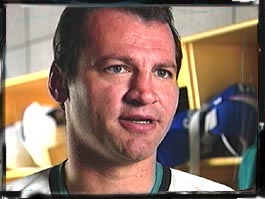|


|
Even though players are on the ice for an average of one minute at a time,
the workout is one of the most intense in professional sports.
|
|
The demands of the game of hockey, along with an 82-game schedule,
take their toll physically and mentally on the players. How do players stay
fit and focused during the season? How do they protect themselves from injuries?
We talked to the Sharks team doctor, conditioning coach, and the players
themselves. We looked at getting fit and staying that way through the season.
In this section, there are RealAudio and video
clips from Sharks Team Doctor Arthur Ting, Strength and Conditioning Coach
Steve Millard, and Sharks Defenseman, Doug Bodger
.
|
|
Holding your breath
Most of the players work hard in the summer. Long gone
are the days when a professional hockey player could just take the summer
off. Weights, bicycles, running, inline skating --players do whatever it
takes in the off-season to stay fit. Sharks Defenseman Doug Bodger told
us that while they work hard all summer, the demands of the game itself
are more intense and it takes a while for everyone to get to point to where
they feel comfortable physically. So just how intense is it on the ice?
Bodger told us, "I don't think you're breathing half the time. You're
mostly exhaling...pushing and shoving...and concentrating so much you don't
think about breathing at all. That's why we can only stay out there for
a minute at a time. It's like holding your breath."
|

|
Sharks Defenseman Doug Bodger talks about what it
takes out on the ice.
|
|
|
Crash Diet
During the course of an average game, some players can
lose as much as 5 to 8 pounds. This loss is mostly water, so players are
concerned about making sure they keep enough fluids in their bodies. Goalies,
who make it to the bench much less often than other players (who have one-minute
shifts), keep a water bottle on top of their goal. Goalies can lose as much
weight as a forward or defenseman. The water bottle on top of the net has
become a part of the game. Occasionally it will move when a goal is scored--this
has been used more than once by replay judges and announcers to help determine
whether a disputed goal should count.
|

|
Sharks Strength and Conditioning Coach, Steve Millard,
discusses players' weight fluctuations during the year.
|
|

|
|
Some players lose more than just water. Many players will
lose weight during the course of the season. In an extreme case, Sharks
Captain Todd Gill went from 180 pounds to 165 pounds (82 to 74 kg) over
the course of the 1996 season. Injuries to teammates and large numbers of
penalty killing situations gave the Sharks' captain more than his share
of ice time. Sharks Strength and Conditioning Coach Steve Millard told us
that the team monitors the players weight and that, "Fifteen pounds
is more significant than we like to see." They gave Gill nutritional
supplements to help him keep his body weight up. Millard told us that it
was typical for a player to lose 6 or 7 pounds (3 kg) in fat and lean body
mass during the course of the season. So why is weight loss a concern? Apparently,
losing that much weight indicates that a player is constantly having his
system broken down and he is not recovering. In this situation, he is losing
muscle mass and may be more susceptible to injury.
|
|
Click the "forward"
button below to continue.
|

©
Exploratorium
|